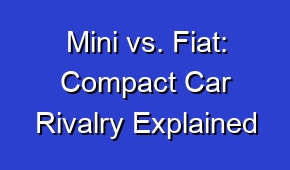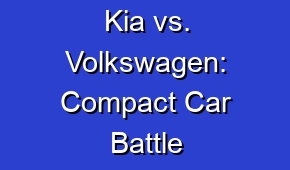Skoda Superb Estate 2014 Vs Hyundai ix35 S 2014

Compare the Skoda Superb Estate 2014 and Hyundai ix35 S 2014 to find your perfect car. Discover the key features, performance, and design of these two popular models. Make an informed decision for your next vehicle purchase.
| Feature | Skoda Superb Estate 2014 | Hyundai ix35 S 2014 |
|---|---|---|
| Engine | 2.0L TDI Diesel | 1.7L CRDi Diesel |
| Horsepower | 140 HP | 115 HP |
| Torque | 320 Nm | 260 Nm |
| Transmission | 6-speed Manual | 6-speed Manual |
| Fuel Efficiency (combined) | 5.1 L/100km | 5.7 L/100km |
| Acceleration (0-100 km/h) | 9.8 seconds | 12.4 seconds |
| Top Speed | 210 km/h | 173 km/h |
| Seating Capacity | 5 | 5 |
| Cargo Capacity | 633 liters | 591 liters |
| Infotainment System | 6.5-inch touchscreen, CD/MP3 player | 5-inch touchscreen, CD/MP3 player |
| Bluetooth Connectivity | Yes | Yes |
| USB Port | Yes | Yes |
| Auxiliary Input | Yes | Yes |
| Steering Wheel Controls | Yes | Yes |
| Front Airbags | Yes | Yes |
| Side Airbags | Yes | Yes |
| ABS | Yes | Yes |
| Electronic Stability Control | Yes | Yes |
Engine
The Skoda Superb Estate 2014 is equipped with a 2.0L TDI Diesel engine, while the Hyundai ix35 S 2014 has a 1.7L CRDi Diesel engine. The Skoda offers a slightly larger engine size, which may result in improved performance and power.
Horsepower
With 140 HP, the Skoda Superb Estate 2014 has a higher horsepower rating compared to the Hyundai ix35 S 2014, which offers 115 HP. This means that the Skoda may deliver better acceleration and overall performance on the road.
Torque
The Skoda Superb Estate 2014 boasts a torque of 320 Nm, surpassing the 260 Nm torque of the Hyundai ix35 S 2014. Higher torque can provide better pulling power and enhanced performance, especially during overtaking or when carrying heavy loads.
Transmission
Both vehicles come with a 6-speed manual transmission, providing drivers with control over gear shifts. This manual transmission setup allows for a more engaging driving experience and the ability to optimize gear selection based on driving conditions and preferences.
Fuel Efficiency (combined)
The Skoda Superb Estate 2014 offers better fuel efficiency with a combined rating of 5.1 L/100km, compared to the Hyundai ix35 S 2014 with a rating of 5.7 L/100km. This means that the Skoda may provide more economical fuel consumption, resulting in potential savings at the pump.
Acceleration (0-100 km/h)
The Skoda Superb Estate 2014 demonstrates quicker acceleration, reaching 0-100 km/h in 9.8 seconds, while the Hyundai ix35 S 2014 takes 12.4 seconds. The Skoda’s faster acceleration may contribute to a more dynamic driving experience and better performance in overtaking maneuvers.
Top Speed
The Skoda Superb Estate 2014 has a higher top speed of 210 km/h compared to the Hyundai ix35 S 2014, which reaches a top speed of 173 km/h. This higher top speed may be advantageous for those who desire faster highway cruising or need to cover long distances quickly.
Seating Capacity
Both the Skoda Superb Estate 2014 and the Hyundai ix35 S 2014 offer seating for up to five passengers. The seating capacity remains the same for both vehicles, providing ample room for a typical family or a group of friends.
Cargo Capacity
The Skoda Superb Estate 2014 offers a larger cargo capacity with 633 liters, while the Hyundai ix35 S 2014 provides 591 liters. The Skoda’s larger cargo space may be beneficial for those who require extra room for luggage, groceries, or other bulky items.
Infotainment System
The Skoda Superb Estate 2014 features a 6.5-inch touchscreen and a CD/MP3 player in its infotainment system. On the other hand, the Hyundai ix35 S 2014 is equipped with a 5-inch touchscreen and a CD/MP3 player. Both vehicles offer basic multimedia functionalities for entertainment purposes.
Bluetooth Connectivity
Both the Skoda Superb Estate 2014 and the Hyundai ix35 S 2014 are equipped with Bluetooth connectivity. This feature allows drivers to connect their mobile devices wirelessly to the car’s audio system, enabling hands-free calling and audio streaming for a safer and more convenient driving experience.
USB Port
Both the Skoda Superb Estate 2014 and the Hyundai ix35 S 2014 come with a USB port, allowing users to connect and charge their compatible devices. This feature enables easy access to personal media files and ensures convenient device charging while on the go.
Auxiliary Input
Both vehicles are equipped with an auxiliary input, providing an additional option for audio connectivity. This allows users to connect external devices, such as MP3 players or other audio sources, to the car’s audio system for personalized music playback.
Steering Wheel Controls
Both the Skoda Superb Estate 2014 and the Hyundai ix35 S 2014 feature steering wheel controls. These controls allow drivers to conveniently adjust audio settings, manage phone calls, and access other essential functions without taking their hands off the steering wheel, enhancing safety and convenience.
Front Airbags
Both vehicles are equipped with front airbags, providing essential safety protection for the driver and front passenger in the event of a collision. Front airbags are designed to deploy rapidly and help reduce the risk of severe injuries during frontal impacts.
Side Airbags
Both the Skoda Superb Estate 2014 and the Hyundai ix35 S 2014 are equipped with side airbags. These airbags are designed to provide additional protection to the occupants in the event of a side-impact collision, reducing the risk of injury to the chest and torso areas.
ABS (Anti-lock Braking System)
Both vehicles come with ABS, an essential safety feature that prevents the wheels from locking up during hard braking, allowing the driver to maintain steering control. ABS helps reduce the risk of skidding and enhances overall braking performance, especially on slippery or uneven road surfaces.
Electronic Stability Control
Both the Skoda Superb Estate 2014 and the Hyundai ix35 S 2014 are equipped with electronic stability control. This feature helps maintain vehicle stability by detecting and reducing instances of skidding or loss of traction. It can intervene by applying individual brakes or reducing engine power to help the driver maintain control in challenging driving conditions.



















